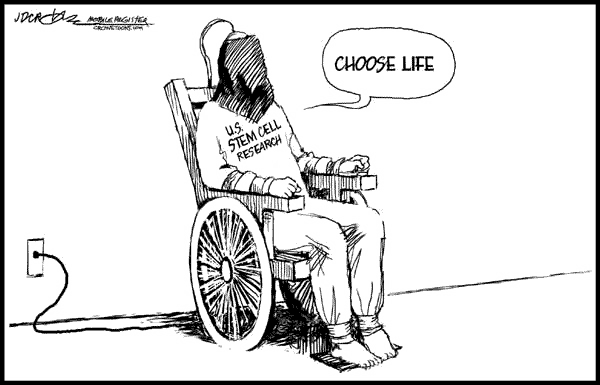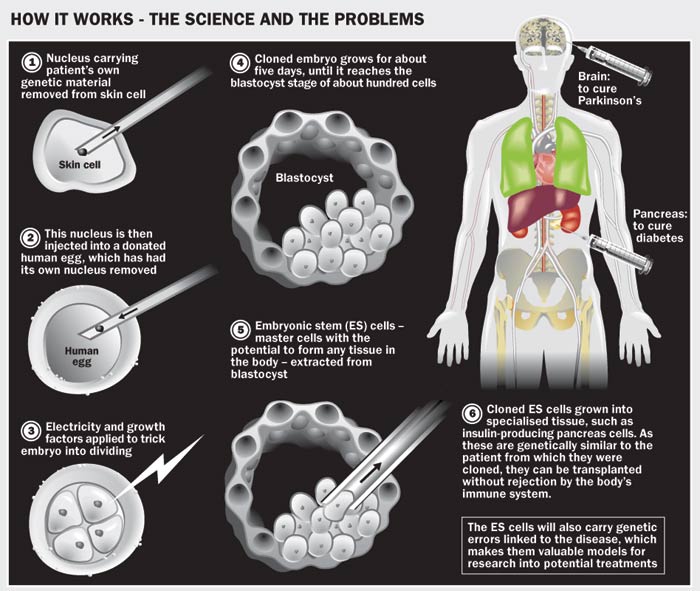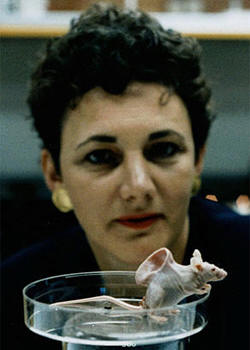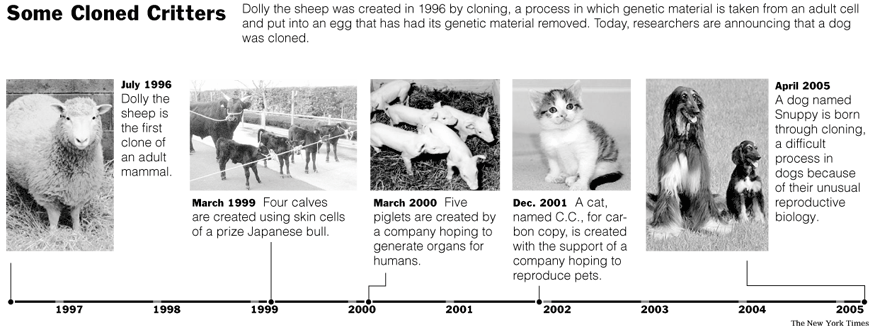|
Vocapedia >
Health >
Genetics > Cells
> Cloning

Mike Thompson
The Detroit Free Press
Detroit, Michigan
Cagle
8 August 2005
http://cagle.msnbc.com/politicalcartoons/PCcartoons/thompson.asp

J.D. Crowe
The Mobile Register
Alabama
Cagle
31.5.2005
http://www.crowetoons.com/
life
cell
embryonic stem cell debate
UK / USA
http://www.nytimes.com/2005/05/25/politics/25stem.html
https://www.theguardian.com/world/2005/may/25/usa.stemcells
http://www.nytimes.com/2005/05/21/politics/21stem.html
embryo cloning
UK
https://www.theguardian.com/science/2005/feb/08/
genetics.science
human-animal embryos / hybrid and chimeric embryos
UK / USA
http://www.theguardian.com/politics/2007/apr/05/
genetics.topstories3
Australia legalizes the cloning of human
embryos
for stem cell research 2006
http://www.usatoday.com/tech/science/genetics/2006-12-06-
australia-cloning_x.htm
Human Fertilisation and Embryology Act 1990 (c.
37)
http://www.legislation.gov.uk/ukpga/1990/37/contents
cloned embryos from adult monkeys
USA 2007
http://www.guardian.co.uk/science/2007/nov/14/stemcells.usnews
British scientists create first pure brain stem
cells 17.8.2005
https://www.theguardian.com/society/2005/aug/17/health.genetics
clone a human
embryo 2005
http://www.economist.com/node/4002772
https://www.theguardian.com/uk/2005/may/20/sciencenews.science
https://www.theguardian.com/science/2005/may/20/genetics.health
https://www.theguardian.com/science/2005/may/20/genetics.science
http://www.theguardian.com/news/2005/may/20/leadersandreply.mainsection

President Bush appeared at the White House
with babies and toddlers born of
test-tube embryos,
some wearing shirts that read "former embryo."
Photograph: Susan Walsh
Associated Press
House Approves a Stem Cell Research Bill Opposed by Bush
By SHERYL GAY STOLBERG NYT
Published: May 25, 2005
http://www.nytimes.com/2005/05/25/politics/25stem.html
grow new
organs
treat diabetes
patients
create insulin-producing cells
be transplanted to N

Race to find new cures speeds up as Britain
clones human embryo
The Times
20 May 2005
http://www.timesonline.co.uk/article/0,,2-1619958,00.html

http://tlc.discovery.com/convergence/
superhuman/photo/zoom_03.html
added c. 2002
clone / clone
human being
human proteine
human clone
cloned human
embryo UK
https://www.theguardian.com/society/2004/jun/13/
health.research
a milestone in
biological research
nuclear transfer
technique
clone human embryos for therapeutic purposes
clone humans for reproductive purposes
create carbon copies of people

http://www.genetics-and-society.org/images/media/Lab_of_human_clone.jpg
added 13.4.2005
cloning
human cloning
http://www.guardian.co.uk/science/2013/may/18/
human-cloning-heart-disease-genes
Orphan Black
UK
television drama
that plunges into the moral
minefield of human cloning
http://www.theguardian.com/tv-and-radio/2014/mar/08/
bbc-three-orphan-black-a-worldwide-hit
human genome
genome project
human code
the entire
genetic code of a human being
sequence
decode
unlock
crack

Peaches, right,
9 months old,
is a clone of Mango, 2 years old.
Andy Manis for The New York Times
Hello Kitty, Hello Clone
NYT By ANNE EISENBERG
Published: May 28, 2005
http://www.nytimes.com/2005/05/28/business/28clone.html
traditionally
bred livestock
animal cloning
pets cloning
UK
https://www.theguardian.com/science/2006/may/11/
stemcells.genetics
copy
Dolly the sheep 1996-2003
the world's first animal
to
be cloned from an adult cell
https://www.nature.com/collections/fmwzfbcrym
http://www.npr.org/sections/health-shots/2016/07/26/
487047575/clone-sisters-of-dolly-the-sheep-are-healthy-alive-and-kicking
http://www.npr.org/2016/07/05/
484832430/20-years-ago-a-cloned-sheep-named-dolly-was-born
https://www.theguardian.com/science/2003/feb/15/
genetics.animalrights
test-tube
animals
adult barnyard
clones
cloned meat
https://www.theguardian.com/science/2006/may/11/
stemcells.genetics
genetically modified mouse
2007
https://www.theguardian.com/science/video/2007/dec/12/
mouse
cloned embryo
surrogate mother
genetic mother
foetus, foetuses
ethics
DNA
strand of DNA
egg
human ovum
fertlilised by N
skin cell
cloned babies
'designer babies'
https://www.theguardian.com/science/2005/apr/28/genetics.health
Human and Fertilisation and Embryology
Authority HFEA
UK fertily regulator
Impartial, accurate information about IVF,
clinics and other fertility treatments
from the UK government fertility regulator
https://www.hfea.gov.uk/

Beating Hurdles, Scientists Clone a Dog for
a First
NYT
4 August 2005
https://www.nytimes.com/2005/08/04/
science/beating-hurdles-scientists-clone-a-dog-for-a-first.html

February 19, 2001
Vol. 157 No. 7
http://content.time.com/time/magazine/0,9263,7601010219,00.html

March 10, 1997 Vol. 149 No. 10
http://content.time.com/time/magazine/0,9263,7601970310,00.html

November 8, 1993 Vol. 142 No. 19
http://content.time.com/time/magazine/0,9263,7601931108,00.html
Corpus of news articles
Health > Genetics > Cells > Cloning
Scientists Claim
to Clone Monkey Embryos
November 14, 2007
Filed at 7:40 a.m. ET
The New York Times
By THE ASSOCIATED PRESS
NEW YORK (AP) -- Scientists in Oregon say they've reached the
long-sought goal of cloning monkey embryos and extracting stem cells from them,
a potentially major step toward doing the same thing in people.
The research has not been published yet or confirmed by other scientists. But if
true, it offers fresh hope in field that has been marked by frustration and even
fraud. The claim of a similar breakthrough with human embryos by a South Korean
scientist in 2004 turned out to be false.
The hope is that one day, such a procedure could be used to create transplant
tissue that's genetically matched to an ailing patient. Because stem cells can
form all types of tissue, the approach might one day help treat conditions like
diabetes and spinal cord injury without fear of rejection by the patient's body.
Scientists have tried for years to clone monkey embryos and extract stem cells
because monkeys are more closely related to humans than other lab animals are.
So monkey work has been expected to give hints about how to do this in people.
The success was reported earlier this year at a scientific meeting in Australia
by Shoukhrat Mitalipov of the Oregon National Primate Research Center in
Portland. It received limited media attention at the time, but the results were
given new attention Tuesday by a London newspaper, The Independent.
Mitalipov did not immediately respond Tuesday to an interview request from The
Associated Press. But another scientist, Jose Cibelli of Michigan State
University, told The AP on Tuesday that he'd heard Mitalipov's presentation at
the Australia meeting.
''To me, it's a breakthrough,'' said Cibelli, who studies cloning and stem
cells. The work shows ''it is possible.''
In cloning to obtain stem cells, DNA from an adult animal is inserted into an
unfertilized egg. The egg is grown into an early embryo, from which stem cells
are extracted. These stem cells, and the tissue that develops from them, will be
a genetic match to the source of the DNA.
The idea of doing this in people is controversial because the embryos have to be
destroyed to obtain the stem cells.
Despite the monkey success, ''we're still far off to start dreaming about
translating this technique to humans,'' Cibelli said. That's because the
reported results were very inefficient, requiring many eggs to produce stem
cells, he said.
Still, the work shows monkeys can be used to study the potential of embryonic
stem cells produced through cloning, Cibelli said. ''That's a terrific tool.''
Cloning is most famous for producing not stem cells but baby animals, such as
Dolly the sheep. But while some people may view the new development as a move by
scientists on the ''slippery slope'' toward producing cloned human babies,
''we're all opposed to that,'' Cibelli said.
Jim Newman, a spokesman for the Oregon Health & Science University, which
operates the primate center where Mitalipov works, declined to confirm whether
the scientist had cloned monkey embryos. But he said a study in that area of
research will be released soon by the scientific journal Nature.
Katie McGoldrick, a Nature spokeswoman in Washington, said she could not discuss
papers that may or may not have been submitted for publication.
The primate center was in the news for another reason Tuesday. An activist
group, People for the Ethical Treatment of Animals, said it had documented
violations of animal protection laws there. University officials said the
primate center has an excellent record for animal care.
Scientists Claim to
Clone Monkey Embryos,
NYT, 14.11.2007,
http://www.nytimes.com/
aponline/us/AP-Monkey-Clones.html - broken link

Cloning: a giant step
For the first time,
scientists have created
dozens of cloned
embryos
from adult primates.
But what are the implications
of this technical
breakthrough
for the future of mankind?
Published: 12 November 2007
The Independent
By Steve Connor,
Science Editor
A technical breakthrough has enabled scientists to create for
the first time dozens of cloned embryos from adult monkeys, raising the prospect
of the same procedure being used to make cloned human embryos.
Attempts to clone human embryos for research have been dogged by technical
problems and controversies over fraudulent research and questionable ethics. But
the new technique promises to revolutionise the efficiency by which scientists
can turn human eggs into cloned embryos.
It is the first time that scientists have been able to create viable cloned
embryos from an adult primate – in this case a 10-year-old male rhesus macaque
monkey – and they are scheduled to report their findings later this month.
The scientists will also demonstrate that they have been able to extract stem
cells from some of the cloned embryos and that they have managed to encourage
these embryonic cells to develop in the laboratory into mature heart cells and
brain neurons.
Scientists who know of the research said it was the breakthrough that they had
all been waiting for because, until now, there was a growing feeling that there
might be some insuperable barrier to creating cloned embryos from adult primates
– including humans.
The development will not be welcomed in all quarters. Opponents of cloning will
argue that the new technique of manipulating primate eggs to improve cloning
efficiency will lead to increased attempts at creating – and destroying – cloned
human embryos for research purposes.
Although it is illegal in Britain to place any such cloned embryos into the womb
of a woman, many people also fear that the relative ease of being able to
perform cloning using the skin cells of an adult will increase the chances of
its being applied to produce a cloned baby. Scientists in South Korea reported
in 2004 that they had created the first cloned human embryo but in 2006 their
study was retracted after it emerged that its main author, Hwang Woo-suk , had
committed fraud.
There has only been one other documented example of a human embryonic clone, but
it died after a few days and did not produce stem cells. The work has so far not
been replicated.
The scientists who carried out the latest primate work are believed to have
tried to implant about 100 cloned embryos into the wombs of around 50 surrogate
rhesus macaque mothers but have not yet succeeded with the birth of any cloned
offspring.
However, one senior scientist involved in the study said that this may simply be
down to bad luck – it took 277 attempts, for instance, to create Dolly the
sheep, the first clone of an adult mammal.
The work was led by Shoukhrat Mitalipov, a Russian-born scientist at the Oregon
National Primate Research Centre in Beaverton. Dr Mitalipov helped to pioneer a
new way of handling primate eggs during the cloning process, which involved
fusing each egg with a nucleus taken from a skin cell of an adult primate.
Dr Mitalipov said he was unable to comment on the study until it was published
in the journal Nature. But he told colleagues at a scientific meeting this year
that he had made two batches of stem cells from 20 cloned embryos and tests had
shown they were true clones.
Professor Alan Trounson of Monash University in Australia said Dr Mitalipov's
findings represented the long-awaited breakthrough. Despite many attempts, no
one had been able to produce cloned primate embryos from adult cells, yet this
had been done on dozens of other non-primate species. " This is 'proof of
concept' for the primate. It has been thought by some [to be too] difficult in
monkeys – and humans – but those of us who work [with] animals such as sheep and
cattle thought that success rates would be much like that achieved in these
species," Professor Trounson said.
"Mitalipov's data confirms this. They have the skills necessary and we can now
move on to consider what might be able to be achieved in humans."
Professor Don Wolf, who led the laboratory at the Oregon National Primate
Research Centre before his recent retirement, said the new procedure was based
on a microscopic technique that does not use ultraviolet light and dyes, which
appear to damage primate eggs.
"In the early days we tried to use that technique in the monkey and unbeknownst
to us at the time that was basically damaging the egg. So one of the keys was to
remove that step from the process," Dr Wolf said.
"We could now produce cloned blastocysts [embryos] in the monkey at a reasonable
frequency, at least a frequency that would allow us ...to study the cloned
blastocyst ," Professor Wolf said.
The Oregon team, working with a group in China, has so far produced about 100
cloned embryos that have been transferred into around 50 female macaques, but
none has resulted in a full-term pregnancy, he said.
"It's possible that we're still just having bad luck. We're producing may be one
in 20 or one in 30 cloned blastocysts that are 'normal' and capable of producing
a pregnancy and we just haven't got them into the animal recipient at the right
time to allow implantation and pregnancy to occur," Professor Wolf said.
"The focus now is going to be on therapeutic cloning and using the non-human
primate as a paradigm for therapeutic cloning for what you might be able to do
clinically," he said.
"We're the first to do it, although it's a tainted subject because of the
fraudulent research that came out of South Korea. One can never be sure but
there may be some validity to what the South Koreans did. But this would now be
the first documented therapeutic cloning in a primate," he added.
A brief history of cloning
The monkey-cloning technique is the same basic procedure that resulted in Dolly
the sheep. The nucleus of a healthy, unfertilised egg is removed and another
nucleus from the mature skin cell of an adult animal is placed inside the egg.
With careful timing and the use of electrical pulses, an embryo can be created
which is a genetic clone of the skin tissue donor. It is possible to implant
embryos created in this way into the womb to produce cloned animals. This
so-called 'reproductive cloning' of humans is illegal in Britain and many other
countries. However it has been applied to a range of animal species, including:
* Cow: Many domestic cattle have been successfully cloned. First attempt to
clone an endangered species was Noah, a rare gaur ox, which was cloned in the US
in 2001 but died 48 hours after birth
* Mouse: Cumulina was a common brown house mouse, cloned from adult cells at the
University of Hawaii in 1997. She survived to adulthood and produced two
litters, before dying in May 2000
* Horse: Called Prometea, the first cloned horse, born in Italy in May 2003
* Cat: A kitten called CopyCat was born in 2002 in Texas, and gave birth to
three kittens by a natural father in September 2006
* Dog: Snuppy, born in South Korea. Doubts about its authenticity were dispelled
by DNA tests. The group has also cloned two wolf cubs, called Snuwolf and
Snuwolffy using the same procedure. Cloned Afghan hounds named Bona, Peace and
Hope have also been born
Cloning: a giant
step, I, 12.11.2007,
http://news.independent.co.uk/sci_tech/article3152325.ece
Steve Connor:
Technical barriers to human cloning
can
evaporate overnight
Published: 12 November 2007
The Independent
Perhaps the most important question raised by the latest study
into primate cloning is whether this brings us any nearer to the prospect of a
cloned human baby. Many scientists would say "no" on the grounds that this is
not the intention of the researchers involved, and in any case such activity is
illegal. I believe they are wrong.
The technology of somatic cell nuclear transfer – cloning of an adult – is
difficult. In 1996, it took 277 attempts to create Dolly the sheep, and the
success rate is still far too low to make it as simple as, say, in-vitro
fertilisation.
Primates – including humans – posed even greater problems than many other
species. No matter how hard scientists around the world tried, they were unable
to clone a monkey offspring from an adult animal. Meanwhile, attempts on human
eggs were mired in scientific misconduct. It has even been suggested that there
may be some inherent barrier to Dolly-style cloning for all primates. However,
the latest research coming out of Oregon suggests that the barrier was due to a
flawed laboratory technique rather than a fundamental biological block.
Although the Oregon scientists have not yet succeeded in producing a cloned
offspring, they have managed to produce dozens of cloned embryos, and some of
them have developed well enough to generate stem cells – the mother cells of the
body from which all specialised tissues derive. The technique will no doubt be
studied by those scientists interested in producing cloned human embryos for the
same purposes.
And if it is possible to improve the efficiency at which an unfertilised human
egg can be merged with an adult's skin cell, then that too would be useful for
anyone contemplating reproductive cloning.
Reproductive cloning is banned in about 50 countries in the world, which means
that it is still legal in the majority of nations. Attempts by the UN to
formulate an international ban ground to a halt a couple of years ago because
some countries wanted a total ban on all types of cloning – such as therapeutic
cloning – which Britain and other nations opposed.
In a report today, the United Nations University calls for a new global
consensus to outlaw reproductive cloning so that there can be no place in the
world where it could be undertaken legally. The problem we all face is that
science is not static and apparent technical barriers to human cloning can
evaporate overnight. If the cloning of human embryos becomes straightforward and
reliable, then someone, somewhere will attempt to transplant a cloned embryo
into the womb of woman. We may not be able to stop such a chilling development.
Steve Connor:
Technical barriers to human cloning can evaporate overnight,
I, 12.11.2007,
http://comment.independent.co.uk/commentators/article3152326.ece
World's first cloned cat has kittens
Posted 12/15/2006
9:01 AM ET
USA Today
AP
COLLEGE STATION, Texas (AP) — The world's first cloned cat
just became a mother — and she even did it without test tubes. Copy Cat, who was
cloned by Texas A&M University researchers in 2001, had three kittens in
September. Mother and kittens are doing well, said Duane Kraemer, an A&M
veterinary medicine professor who helped clone her and has been taking care of
her since.
"They're cute and we thought people ought to know about the
birth," Kraemer said. "But we're hoping it doesn't cause the same frenzy CC
did."
CC got worldwide attention after she was cloned at Texas A&M, which has cloned
more species than any institution in the world, including cattle, swine, goats,
horses and a deer.
The father is Smokey, a naturally born tabby who was brought in to mate with CC.
Two of the kittens take after their mother, while the third has a gray coat like
his father.
CC is not the first cloned cat to give birth, Kraemer said. In New Orleans, two
cloned wild African cats successfully mated to produce kittens.
World's first cloned
cat has kittens,
UT,
15.12.2006,
https://usatoday30.usatoday.com/tech/
science/genetics/2006-12-15-
cloned-cat-kittens_x.htm
Related > Anglonautes >
Vocapedia
genetics
body,
health, medicine, drugs,
viruses, bacteria,
diseases / illnesses,
hygiene, sanitation,
health care / insurance
mental health, psychology
health,
contraception, abortion,
pregnancy, birth, life,
life expectancy,
getting older / aging,
death
USA > prescription opioid painkillers
lifestyle, health >
exercise,
smoking / tobacco, vaping,
drinking / alcohol,
diet, obesity
|